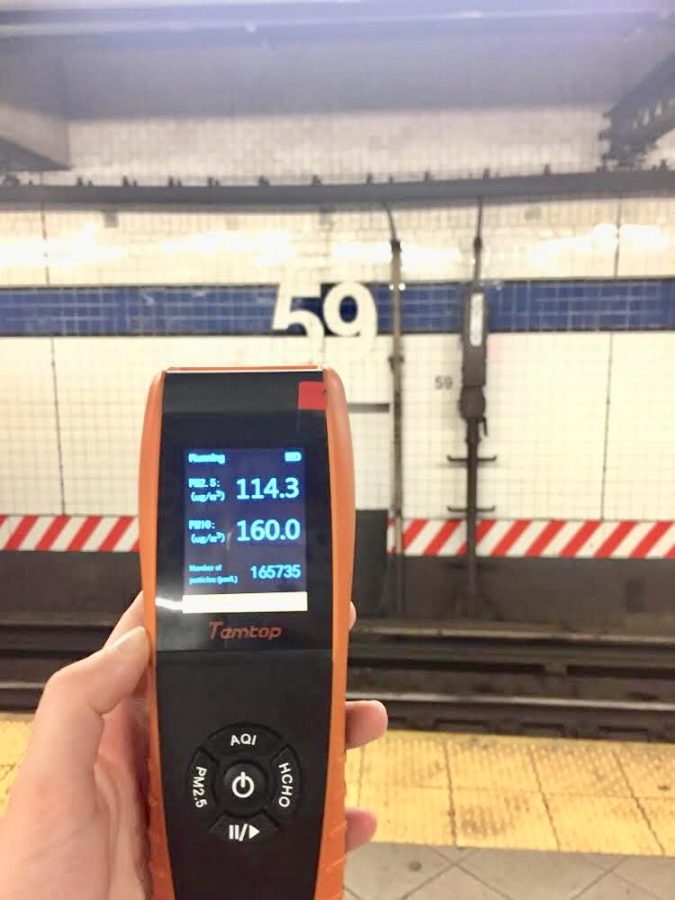Fordham Senior Researches Air Pollution in the Bronx
By Sarah Huffman
Natalie Ward, FCRH ’19, is researching the air pollutant pm2.5 and its effects on respiratory health, specifically asthma, in the Bronx.
Ward studies PM2.5, a fine particulate matter which is an air pollutant categorized by the EPA as harmful for human health. She became interested in the air pollutant when she was a researcher with project Teens Researching Urban Ecology (TRUE) during the summer of 2017.
One of the devices they worked with was an air beam, which is a measurement tool that records the amount of PM2.5 in the air. Ward said she thought the air beam was interesting and wanted to use it more.
“I thought it was so fascinating to be able to research something that can’t be seen with the naked eye,” she said. “The crazy thing about PM2.5 is that it’s about ⅙ the size of a cross section of your own human hair so it’s incredibly small and it has the ability to reach deep into your respiratory tract and cause great harm to your lungs.”
While researching with project TRUE, they discussed environmental topics often, including the rate of pediatric asthma in the Bronx.
Ward said the Bronx has one of the highest rates of pediatric asthma in the country, and she was curious as to why. She said she learned about air quality and how air pollutants can affect respiratory health, and she wanted to see if there was a link between PM2.5 and asthma. She was especially invested after learning that the Belmont community, has one of the highest rates of asthma in the country.
Ward said for her research, she goes to a variety of locations throughout the Bronx to record values of PM2.5. The values observed are consistently harmful for respiratory health, specifically vulnerable populations, which includes children and those with existing conditions.
“It’s pretty shocking to sit in different parks of the borough and see kids, families, dads and moms, all playing, enjoying the outdoors but to see these values of air pollutants that are extremely high and toxic,” she said.
The EPA air quality index, which gives measures of what is deemed safe for human health, what is harmful for sensitive populations and what is dangerous for anyone, found that the levels of PM2.5 concentrations are consistently harmful.
Ward also became interested in the air quality of the subway system after taking her device out on the train one day and seeing that the levels of PM2.5 were higher than any level ever seen at street level.
Ward now rides the train systems to see different levels of PM2.5. The levels are consistently harmful not only for sensitive populations, but also for the general population.
Ward was also curious to see how PM2.5 concentrations vary based on depth of subway platform. She said the deeper you go, the higher the concentrations of the air pollutant. She is working on using the differential equation to potentially model the distribution.
Her goal is to conduct air quality tests in all five boroughs. She wants to see how the concentrations differ in other boroughs and even other metropolitan cities.
“My dream would be to be part of a team of researchers investigating air quality in New York. And maybe one day conducting a comparison study of different cities in the nation and throughout the world,” said Ward.
Ward said she is proud of her research because it can benefit the community at large. “Investigating this pollutant says a lot about the health of the Belmont neighborhood,” she said. “This can inform policy makers to employ stricter regulations on pollutants and things that cause pollutions.”
“My research is not only something that I’m interested in but something that many people can understand,” she said. “As cities become more and more dense and as more shipping companies and cars are added to our roads, it’s important to find out the effects of major polluters and see how they contribute to human health positively or negatively.”
She said there must be more research about air pollution and asthma. Ward thinks that while scientists are currently doing a lot of work on the topic, there could always be more.
Ward presented her project twice at the Fordham Undergraduate Research Colloquium and said people are always shocked to hear that the air quality is so poor. “It shows how much we don’t know about air quality and how we should research the potential causes of high levels of PM2.5,” she said.
Ward started researching this past summer as part of Fordham’s undergraduate research grant. She said she was awarded the grant after a committee looked at her proposal, and she has been working with Dean Annunziato throughout the project.
She said the impact of Fordham undergraduate research has been really empowering.
“I never thought I could design my own study, implement it and then see results. I really loved being able to create my own project and then see it through,” she said.













































































































































































































